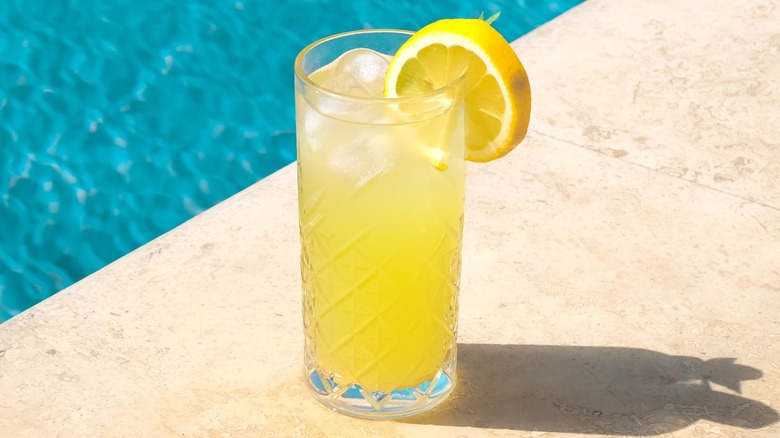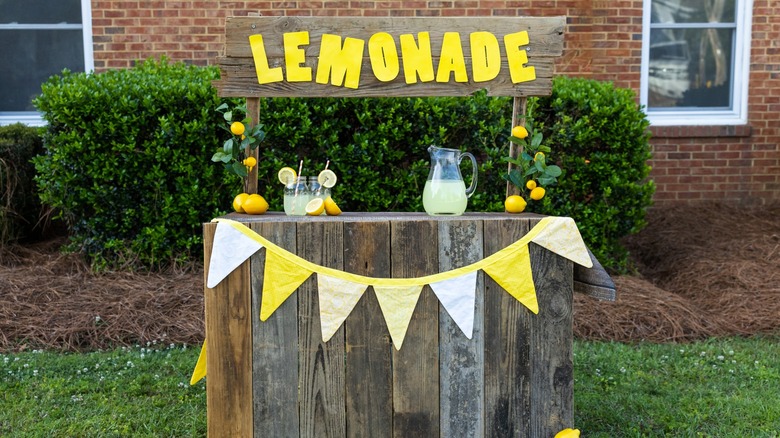Where Did Lemonade Originate?
The old adage "if it's not broke, don't fix it" could have been written about lemonade. The refreshing drink is a simple, straightforward combination of lemon juice, water, and sweetener, but folks have been enjoying it for at least 1,000 years. In fact, foodies have been following the cheery advice to "make lemonade out of lemons" basically for as long as the fruit has grown on planet Earth. And lemons are one of the oldest fruits in cultivation.
They began cropping up in China, India, and western Polynesia (before the lemon was the citron, a far less tasty and less juicy fruit), and the fruits made it to Egypt by 700 C.E. Folks were cultivating lemons as early as the 900s, and lemonade was quickly on its way in Cairo. According to the accounts of everyday Egyptian life recorded by the Persian poet Nasir-I-Khusraw, the city's medieval Jewish community was trading a bottled sweetened lemon juice called qatarmizat to other cultures by 1100, which might have been how lemonade first gained popularity.
Fast forward to the 17th century, and a fizzy proto-lemonade made with lemon juice, sparkling water, and honey took Rome and Paris by storm. The bevy was sold en-masse by street vendors in pre-Revolution France called limonadiers, who peddled lemonade on foot from massive, innovative tanks strapped to their backs. In 1676, the merchants organized into a guild called the Compagnie de Limonadiers due to their sheer volume. Suffice it to say, lemonade mania had hit and hit hard.
An evolving elixir
In the U.K., the 1827 mixology guidebook "Oxford Night Caps" describes a lemonade recipe with downright bizarre ingredients (think raw eggs and gelatin made from calves feet). Lemonade remained in a state of constant evolution for some time before becoming the sweet, simple, modern classic that fans know and love today. The first American lemonade recipe cropped up in 1838, and as early as 1879, entrepreneurial foodies in the U.S. were selling a version of the beverage sweetened with molasses to the weary, thirsty travelers at Ellis Island. (Whether molasses or sugar was the most popular sweetener at the time remains unclear.)
For a while, egg whites were a common lemonade ingredient, giving the drink froth and a luscious mouthfeel. Perhaps the egg whites left the picture around the late 19th century, when lemonade stands became a popular capitalist venture among the children of New York City (start 'em young!). Deliciousness and ease aside, lemonade's enduring prominence in the American market is largely owed to the Women's Christian Temperance Movement of the 19th century, which championed the drink as an alternative to alcohol.
Outspoken Temperance leader First Lady Lucy Webb Hayes (1877 to 1881) even earned the nickname "Lemonade Lucy" for her dedication to the cause. Nowadays, in a sort of ironic full-circle moment, lemonade has since gone on to inspire a wide array of hard seltzers and teamed up with gin to create the classic Tom Collins cocktail. And the popular bottled lemonade of mid-1800s London contained lemon oil and citric acid, which some historians consider the first-ever sour mix.
Lemonade moved to the commercial sphere
By the 1830s, Schweppes fizzy lemonade was dominating the commercial market as the German-Swiss jeweler Johann Jacob Schweppe developed a method of force-carbonating using a compression pump. Today, lemonade remains more commonly served fizzy in the U.K., while it's predominantly carbonation-free in the U.S. Over the years, retailers have drummed up business using non-gastronomic tactics, as well.
When the 1918 influenza pandemic struck America, Sunkist boosted its nationwide lemonade sales by over 80% by marketing lemonade as a cure. Quoth the advertisement (via The Museum of Ventura County): "Avoid crowds, take adequate exercise, get plenty of sleep, and drink one or two glasses of hot lemonade daily." Still, the lemonade business has always rested largely in the hands of the people.
As a July 1880 article by The New York Times raves, "This cheap lemonade business has come very much to the front in New York within the last year or two, and it is an excellent idea. Before, if a thirsty soul wanted a glass of lemonade on a hot day, he had to go into some bar room and pay 15 cents for it. Now, at any one of these lemonade stands — and scores of them have been established — a customer can have a glass of ice-cold lemonade, made before his eyes, for 5 cents." The idea stuck around, too. Norman Rockwell drew "Lemonade Stand" in 1955, a lasting symbol of retro, nostalgic Americana kitsch.


